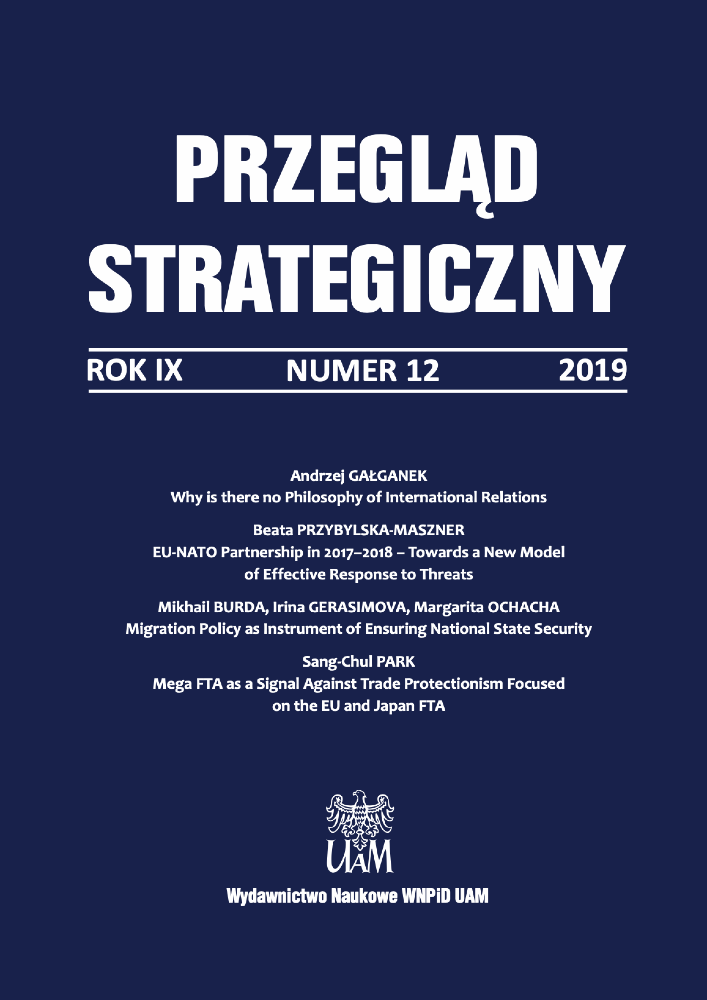Abstrakt
Celem artykułu jest wskazanie czynników warunkujących stan relacji Unia Europejska – NATO po roku 2017. Przedstawione zostały istniejące determinanty tych relacji, jak i istniejące struktury powiązań międzyinstytucjonalnych obu organizacji. W celu właściwego rozpatrzenia wskazanych problemów badawczych zastosowano dobór jakościowy źródeł w postaci wybranych aktów prawnych i dokumentów typu soft law omawianych organizacji. Pytania badawcze stawiane w prowadzonej analizie dotyczą źródeł i przejawów dynamiki zmian w relacjach. Odpowiedź na nie udzielona została w oparciu o ukazane determinanty zachowań uczestników procesu decyzyjnego omawianych organizacji. W artykule oparto się na założeniu, iż w omawianym okresie dotychczasowa zasada korelacji zadań UE–NATO oparta na uzupełnianiu potencjału obu organizacji uległa modyfikacji. Powtarzające się sytuacje wymagające wspólnego i wielowymiarowego reagowania na kryzys znacząco zwiększyły obszar możliwego zaangażowania obu strategicznych partnerów i przyczyniły się do wzmocnienia istniejących powiązań. Intensyfikacja działań na rzecz rozwoju WPBiO UE występuje w okresie, gdy znacząco wzrosła liczba sporów politycznych dotycząca roli obu podmiotów w nowym układzie sił strategicznych. Europejskie ograniczenia w zakresie realnych możliwości wojskowego oddziaływania w regionie, umniejszają szanse na efektywną kooperację obu podmiotów.
Bibliografia
Barnier M. Speech at the Berlin Security Conference, 29 November 2017, http://europa.eu/rapid/press-release_SPEECH-17-5021_en.htm (10.2.2019).
Bendiek A. (2017), A Paradigm Shift in the EU’s Common Foreign and Security Policy: From Transformation to Resilience, SWP Research Paper Stiftung Wissenschaft und Politik German Institute for International and Security Affairs, Berlin.
Bakker A., Biscop S., Drent M., Landman L. (2016), Spearheading European Defence: Employing the Lisbon Treaty for a Stronger CSDP. Report, The Hague, Netherlands Institute of International Relations ‘Clingendael’.
Biscop S. (2017), How the EU Can Save NATO, Security Policy Brief, Number 83, Brussels, Egmont, Royal Institute for International Relations, March.
Black J., Hall A., Fox K., Kepe M., Silfversten E. (2017), Defence and Security after Brexit: Understanding the possible implications of the UK’s decision to leave the EU, Compendium Report, RAND Corporation.
Blagden D. (2017), Britain and the world after Brexit, “International Politics” 54(1).
Bratislava Declaration, Bratislava, 16 September 2016, https://www.consilium.europa.eu/media/21250/160916-bratislava-declaration-and-roadmapen16.pdf (15.07.2018).
Council of the European Union, Council conclusions on progress in implementing the EU Global Strategy in the area of Security and Defence, 6 March 2017, Press Release 110/17.
Dakic O. (2015), The state of play of the EU-NATO partnership, European Leadership Network, August 28.
Drent M., Kruijver K., Zandee D. (2019), Military Mobility and the EU-NATO Conundrum, Cligendael Report, July.
Duke S. (2008), The future of EU–NATO relations: a case of mutual irrelevance through competition?, “Journal of European integration”, 30 (1).
European Council Conclusions, 19–20 December 2013, EUCO 217/13.
European Council Conclusions, 15 December 2016, EUCO 34/16.
European Parliament resolution of 13 April 2016 on the EU in a changing global environment – a more connected, contested and complex world, 2015/2272)INI.
European Parliament resolution of 16 February 2017 on possible evolutions of and adjustments to the current institutional set-up of the European Union, A8-0390/2016.
Howorth J. (2017), EU-NATO cooperation: the key to Europe’s security future, “European Security”, 26(3), July.
Implementation Plan on Security and Defence, November 2016, https://eeas.europa.eu/sites/eeas/files/eugs_implementation_plan_st14392.en16_0.pdf (15.07.2018).
Joint declaration on EU-NATO cooperation by President of the European Council Donald Tusk, President of the European Commission Jean-Claude Juncker, and Secretary General of NATO Jens Stoltenberg, 10 June 2018.
Kaim M. (2017), Reforming NATO’s Partnerships, SWP Research Paper 1/2017, Berlin.
Koops J. (2017), Theorising inter-organisational relations: the “EU-NATO relationship” as a catalytic case study, “European security”, 26 (3).
Koppa M. E. (2019), The relationship between CSDP and NATO after Brexit and the EU Global Strategy, FEPS Studies, April.
Manners I. (2002), Normative power Europe: a contradiction in terms?, ”Journal of common market studies”, 40 (2).
Martill B., Sus M., Post-Brexit EU/UK security cooperation: NATO, CSDP+ or ‘French connection’?, “British Journal of Politicsand International Relations”, Vol. 20(4).
Orbie J. (2006), Civilian power Europe: review of the original and current debates, “Cooperation and conflict”, 41 (1): 123–128.
Piasecki M., Instytucjonalne relacje UE z NATO, http://www.psz.pl/117-polityka/instytucjonalne-relacje-ue-z-nato (11.08.2018).
Raik K., Järvenpää P. (2017), A New era of EU-NATO cooperation, How to make the best of a marriage of necessity. Report, ICDS, May.
Reflection Paper on the future of European defence, COM(2017)315 of 7 June 2017, https://ec.europa.eu/commission/sites/beta-political/files/reflection-paper-defence_en.pdf (11.08.2018).
Remarks by President Donald Tusk on EU-NATO cooperation, 10 July 2018, 448/18.
Smith S. J., Gebhard C. (2017), EU-NATO relations: running on the fumes of informed deconfliction, “European Security”, Vol. 26.
Shared Vision, Common Action: A Stronger Europe. A Global Strategy for the European Union’s Foreign and Security Policy, June 2016, https://eeas.europa.eu/sites/eeas/files/eugs_review_web_0.pdf (2.4.2018).
Wallander C. A. (2000), Institutional assets and adaptability: NATO after the cold war, “International organization”, 54 (4).
Whitman R. G. (2016), The UK and EU foreign, security and defence policy after Brexit: Integrated, associated or detached?, “National Institute Economic Review”.
Zyla B. (2016), Who is keeping the peace and who is free-riding?, “International politics”, 53 (3).

